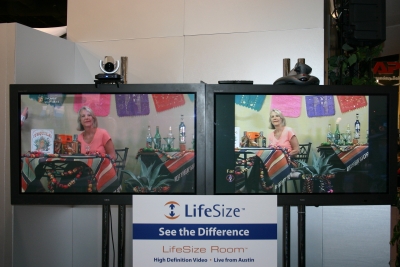Is High Definition video conferencing worth it?

When I blogged about the startup LifeSize Communications last year, the product hadn't actually shipped yet and all the bugs hadn't been worked. In December 2005, the first high definition video conferencing systems from LifeSize shipped and we were treated to multiple real life demonstrations and were communicating to people on the other side of the country at this years Interop convention.
The LifeSize solution operates at a resolution of 720p (1280 x 720) resolution whereas standard definition video conferencing operates at 480p (640 x 480). For the demonstration, a 1 mbps stream was sent over the public Internet to Austin Texas from Las Vegas Nevada. Of that 1 mbps link, 900 kbps were allocated to video and 100 kbps were allocated to 100 kbps wideband audio.

High Definition versus Standard Definition video conferencing
In the picture above showing and HD and SD picture side by side, I thought it was odd that there didn't seem to be too much difference between the images at a distance besides the fact that the HD image fills the entire wide screen. This is surprising because a 720p image has 3 times the pixels of a 480p stream yet the two images looked similar in smoothness from a distance. When I moved to normal viewing distances, I could definitely see a lot more detail in the HD image yet the difference wasn't as obvious as you would think it should be since the SD image wasn't any more pixilated than the HD image. Then it struck me that the reason there wasn't any more pixilation in the SD image was because nearly all modern large screen displays use anti-aliasing technology that removes the pixilation of lower resolution video sources by up sampling them to maximum resolution.
This brings up an interesting technological debate since both video streams use the same data rates of 1 million bits per second. This means that the HD stream obviously has to be compressed 3 times as much as the SD stream to fit in to the same 1 mbps pipe. The only difference is that the SD stream starts out at a lower quality level but doesn't get chopped down as much with compression as the HD stream. Since most modern displays up sample SD video sources to HD resolutions anyways, it would seem to be a wash between the SD and HD solution. But this clearly isn't the case since the HD image is noticeably superior in detail but this sounds like we're getting a free lunch so what could explain this? What's happening is that lower resolution of the SD image indiscriminately throws away finer detail by starting with 3 times fewer pixels whereas the H.264 video compression algorithm has the luxury of picking and choosing what it wants to discard if it had a higher resolution stream to work with. The end result is that while HD video conferencing at 1 mbps can't truly deliver three times the quality of an SD video conferencing at 1 mbps since only 3 mbps HD stream can, it can approximate three times the quality and come close to it under most circumstances when where is little movement or change in the video.
The bottom line is that HD video conferencing is fundamentally superior to SD video conferencing even when you give both of them the same bit rate and you display both on an up sampling display. The really big question is if you should buy it. As it turns out, the $12,000 price tag (list) is the same that you would pay for a high-end standard video conferencing system anyways from any of the more established players in the industry. With all the extra quality in sound and video, it makes video conferencing a lot closer to a face to face meeting so it may end up saving you a lot of travel expenses. With a clear technological lead, LifeSize seems to be on the way up in the world of video conferencing.